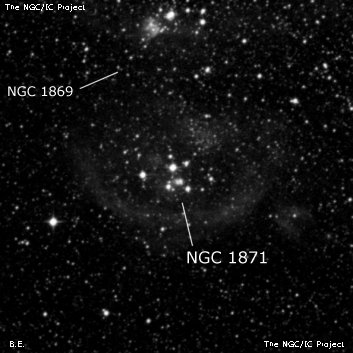
James Dunlop probably discovered NGC 1871 = D 210 on 24 Sep 1826 and recorded "a small round nebula, rather faint. This is the preceding in a line of nebulae and small stars, with a star of the 7th magnitude at the north extremity". Although NGC 1871 is not "preceding in a line", it is the furthest south in a line and his position is just 5' NE of this cluster.
John Herschel independently discovered NGC 1871 = h2800 on 2 Nov 1834 and described "a poor cluster; the southern of three (with NGC 1869 and 1873) of four." On a subsequent sweep he logged "the second of a series of clusters which extend northwards as far as B 922." His mean position from two sweeps is accurate.
300/350mm - 13.1" (2/20/04 - Costa Rica): at 105x, this is a small group of stars in the LMC, 4 stars are resolved in nebulosity. NGC 1873 lies 7' N and NGC 1864 is 12' SW.
600/800mm - 30" (10/12/15 - OzSky): this nebulous cluster contains 5 or 6 bright stars (mag 11.5-13) and 10 stars total, 2' diameter, elongated E-W. A very small nonstellar knot is near the center; a mag 11.8 blue supergiant (HD 34664) is just 25" N and a mag 11.4 star (HDE 269195) is at the E end. Nebulosity encases the stars and is moderately enhanced with an NPB filter. Located at the southeast end of a 15' star cloud (includes LH 32/34/36/37/38) with NGC 1869 = S-L 326 4.6' N and NGC 1873 7' N.
Notes by Steve Gottlieb